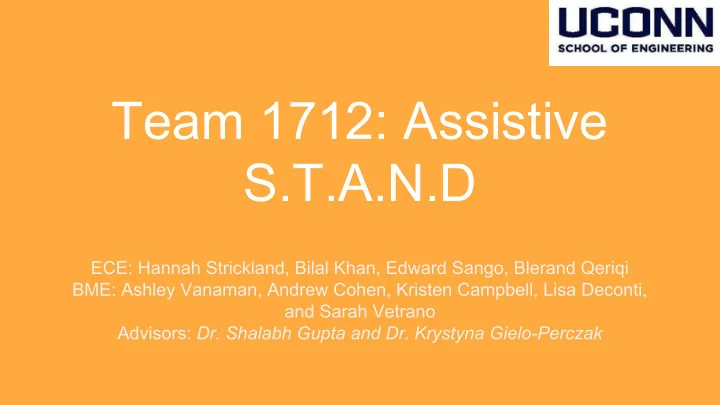

Team 1712: Assistive S.T.A.N.D ECE: Hannah Strickland, Bilal Khan, Edward Sango, Blerand Qeriqi BME: Ashley Vanaman, Andrew Cohen, Kristen Campbell, Lisa Deconti, and Sarah Vetrano Advisors: Dr. Shalabh Gupta and Dr. Krystyna Gielo-Perczak
Outline ● Purpose and Background ● Design Requirements and Restraints ● Biomechanical Analysis ● Final Design ○ Components ○ Final Prototype ○ Future Improvements ● Budget/Timeline
Purpose and Background ● To design a robotic ankle device that assists patients from sit to stand ○ May not provide 100% assistance ● Sit to Stand (STS) ○ Requires Plantar and Dorsiflexion ○ Four Phases ■ Flexion Momentum phase ■ Momentum Transfer Phase ■ Extension Phase ● Center of Mass directly over the Knee and Ankle joints ■ Stabilization Phase
Design Objectives and Constraints ● Size of Patients ○ Max Weight 200 lbs ● User-Friendly ○ Lightweight ( has to be under 5 lbs, goal under 3 lbs) ○ Adjustable ○ Comfortable ○ Safe ● Durable ○ Weather resistant ● Low Cost
Biomechanical Analysis ● Force Platform ○ Forces, moments and center of pressure exerted on the ground ● Anybody software ○ Simulation of a skeleton during STS over a 5 second duration. ○ Explains forces and muscle activity ● EMG ○ Shows muscle activity during STS Anybody confirmed our data from EMG and Force Platform
Biomechanical Analysis What We Found ● Max force reached: 95% of subject weight, with both feet on the platform, one foot is about 45-50% ● The gastrocnemius and soleus are the two main muscles used in the calf for the sit to stand motion ● Muscle activity down the front of the calf we were able to see that these muscles provide less of the force and more of the balance
Final Schematic Force Sensor Artificial Muscle r o t a u t c A
Components ● Brace ○ 3D printed ■ Inner calf support ■ Inner foot support ■ Box for spring ■ Foot piece for additional comfort ● One for both left and right foot ○ Aluminum ■ Structural support ○ S-brackets to attach components ○ Velcro to attach to the patient
Components ● Actuators ○ Max Force: 33lbs ○ Weight: .73 lbs each ○ Speed: .44 inches/sec ○ Stroke: 2 inches ○ Using 12 V/DC at .17 amps ● Artificial Muscle ○ Parts ■ Silicon tubing ■ Cross-linked Techflex tubing ■ (2) 1.75” aluminum rod, d = .5” ● One with ⅛” hole for airflow ■ Brass connector pieces (2) ■ Stainless Steel Hose clamps ■ Air compressor ● 50 psi ○ Force Generated: TBD
Components ● FlexiForce A301 Sensors ○ Force Sensed ■ High 445 N(0 -100lbs) ○ Modifiable Range ■ Change the Voltage Drive: -1.2V ■ Adjusting Resistance of Rf: 100k Ohms ● Tenergy NiMH Rechargeable Batteries ○ 12V ○ Rechargeable ● Microcontroller ○ Arduino Mega 2560 ○ Arduino Motor Shield Rev 3
Pseudo-Code Diagram For Control System Consistent of 3 Main Parts ● Acquisition ○ Processing ○ Activation of ○ Mechanical System
Resulting Prototype ● Weight ○ With all parts: 5lbs ● How it Works ○ As of today: When apply a force to the sensors, the sequence begins ● Testing ○ Sequencing ○ Without test subject: ■ Proof of concept
Conclusions and Further improvements ● Objectives met: ○ Comfortable: Felt insert, Foot insert ○ Adjustability: Foot insert one for left and right ○ Safety: Maximum time for sequence, all components are RoHS compliant ○ Can hold up to 200 lbs ● Future testing: ○ Connect to EMG to test subject while wearing the brace ○ Improve artificial muscle
Budget ● Total Budget ○ $2,000 ● Total Expenses ○ $1,532.58 ● Budget Left Over ○ $467.42
Timeline
Questions?
Components ● Power Supply ○ Tenergy NiMH Rechargeable Batteries ■ 12V ■ 10,000mAh ■ Battery Charging Current: 1A ○ Tenergy NiMH Universal Charger ■ Output 12V, 1A or 2A ■ Temperature sensor to protect from overheating. ■ Selection on 1A or 2A ● Planned to Build One. ○ Budget allowed for more expenses ○ Battery Chosen fits our criteria
Components ● Arduino Mega 2560 ○ Operating Voltage 5V ○ 54 digital input/output pins ○ 16 analog inputs ● Arduino Motor Shield Rev 3 ○ Operating Voltage 5V to 12V ○ Capabilities ■ Distribute Voltage/Current ■ Step Down/Up Voltage ■ L298: Full Bridge Driver ■ Stackable With Mega 2560
Final Design Information
Recommend
More recommend